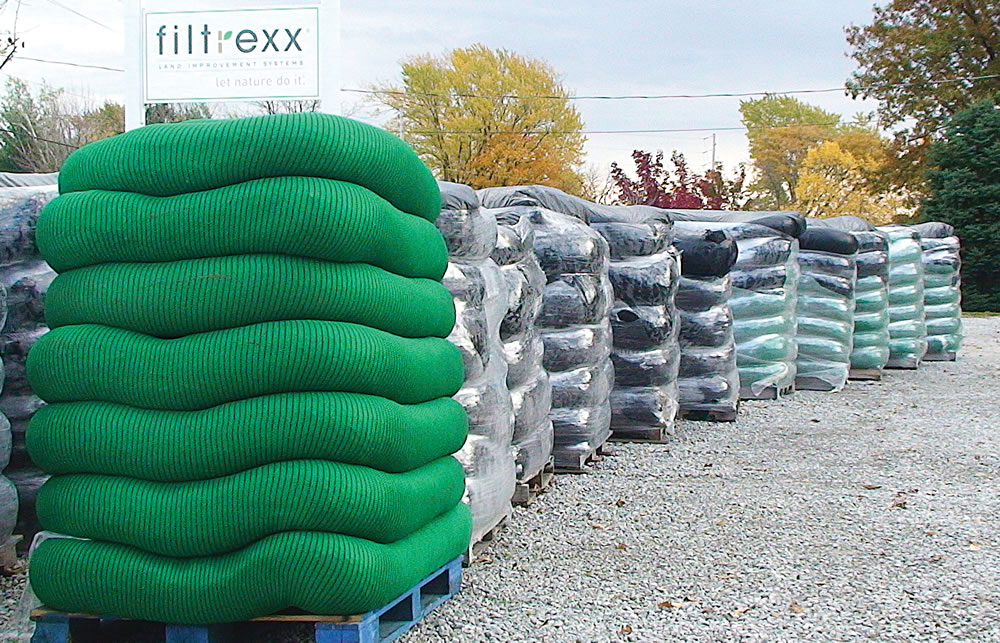Compost marketing entrepreneur grew a company that today uses over a million cubic yards of compost annually.
Nora Goldstein
BioCycle March/April 2017
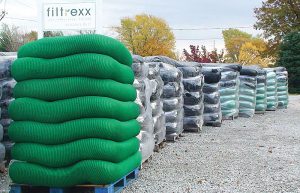
Palletizable Filtrexx Soxx™ that did not slide when stacked on pallets allowed rapid advancement of palletization, which led to scale, which led to what Rod Tyler calls Filtrexx’s “Big Mac®.” Photo courtesy of Filtrexx International
Rod Tyler cut his teeth on the composting industry in the 1990s, first working for Kurtz Bros. Inc. in the Cleveland, Ohio region, then with Browning Ferris Industries (now Republic Industries). “Although I was a ‘marketing guy’ I assisted in operations with both companies, as well with BFI on quality control from a marketing standpoint,” he recalls. “BFI needed adjustments to make quality product in order to sell, which led to me being involved somewhat with their site staff to change screens, grinders, etc.”
Early in his career, Tyler authored an article for BioCycle titled “Diversification At The Compost Factory” (August 1993). While today, the term “compost manufacturer” is commonplace in the industry, Tyler wrote this description almost 25 years ago: “Viewing a composting facility as a manufacturing plant brings to light critical components of a successful operation. Like any manufacturing operation, there is a need for consistency in product quality, which is dependent on the incoming raw materials and the production process. … Supply and demand are crucial in the composting business. Creating demand for supplies that are projected to be ‘endless and overwhelming’ is the marketer’s greatest challenge. Putting composting in an economic and business perspective can help to alleviate some of these concerns.”
And putting composting in an economic and business perspective is exactly what Tyler has done, resulting in the use of over one million cubic yards of compost annually in the erosion and sediment control, horticultural and agricultural industries, and most recently, preventing beach erosion. Those high end compost applications directly translate into a compost value that averages over $150/ton for the company he founded in 2001, Filtrexx International.
BioCycle interviewed Tyler about his journey, which has been anchored by compost from the beginning.
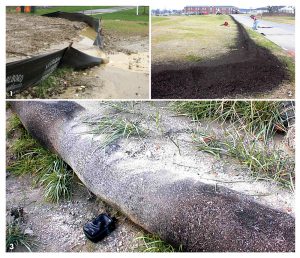
Poor performance of silt fence (1) created a market for a compost-based replacement, initially a compost filter berm (2), followed by
Rod Tyler’s invention, the Compost Filter Sock (3). The socks were more efficient to install and project engineers preferred the containment. Photos courtesy of Filtrexx International
Emerging Market
BioCycle: In your 1993 BioCycle article, you ranked use of compost by Departments of Transportation (DOTs) and state environmental agencies as having lowest value. In the early days of Filtrexx, state DOTs were one of your target markets. What changed in that 8-year time period?
Tyler: The short answer is a huge market opportunity that I didn’t grasp in 1993! And it was connecting an underutilized fraction of finished compost with end uses where that fraction performs better than conventional products used.
Spending time at composting facilities over the years, it had become obvious that one of the largest operational costs is moving materials around the site. Every time an operator touched stuff, e.g., using a 10 cubic yard (cy) bucket loader, it cost $1 to $2/cy in fuel and labor. On the product market side, that cost was imbedded in the screened overs fraction, which had to be moved somewhere and took up valuable storage space. Plus, there was still very valuable material in the overs fraction. So one of the first “aha” moments was realizing how a 3-way screen split instead of the more typical 2-way screen split could help solve this problem. Instead of a 50-50 split of finished compost to overs, operations ended up with a 50-30-20 split of a finer fraction, a medium fraction and overs, saving labor and fuel costs and creating a new product stream. Then we had to figure out markets for that medium fraction, typically a half-inch to 2-inch sized compost.
BioCycle: And how did you figure that out?
Tyler: I remembered an article in the December 1993 issue of BioCycle by Lauren Ettlin and Bill Stewart, “Yard Debris Compost For Erosion Control.” The article reported on an erosion control demonstration project in Portland, Oregon. The goal of the project was to show that yard trimmings compost could be used effectively for erosion control, thus increasing the market for sales of compost. It tested a coarse, unscreened compost and a medium compost screened through a five-eighth-inch trommel, both as a uniform slope cover and as a compost barrier at the base of the slope. Compost applications were compared to a control (untreated bare soil), a sediment fence, and hydromulch. (Reprint of test results in 1993 article online in this article.)
This report about compost berms and blankets was a watershed moment for me. As I looked more into Bill Stewart’s work, it looked like this one single market sector could use all the compost ever produced in the country. And it can — I did the math. But, in my book, Winning The Organics Game: The Compost Marketer’s Handbook, printed in 1996, only a very small part talks about compost use for erosion control. It was listed as an emerging market.
Well, it emerged. Subsequent research studies from academics, government agencies and our own at Filtrexx built on Stewart’s original work. Dr. Britt Faucette, Director of Research for Filtrexx, published over 30 scientific papers in about 10 year period, making Filtrexx the leader in the industry with official research. The new data confirmed the performance of compost, and helped guide our private development of specifications for a variety of applications. These specifications are now standard in nearly every state DOT, U.S. Army Corps of Engineers, U.S. Department of Agriculture, U.S. EPA and other state and federal agencies. In addition, we started a Filtrexx Certified™ FilterMedia™ testing program to make sure the media used has the specific properties necessary to meet the minimum specifications required to reach this level of performance.
BioCycle: At what point in this discovery did you decide to start Filtrexx?
Tyler: I had started a consulting firm in 1996 and was working with some clients in Virginia, Minnesota, Ohio, Pennsylvania and Ontario, Canada to tap erosion and sediment control markets. Installing compost blankets required a significant investment in a blower truck — about $300,000 or more — to apply the compost to the slopes. We introduced seeded compost blankets to compete directly against hydroseed and straw blankets for slope stabilization and vegetation. We also designed compost berms, both seeded and unseeded, to compete against silt fence.
I incorporated Filtrexx International in 2001 to essentially build a national company using certified installers to provide erosion and sediment control and storm water management products and services using compost as our core product. That first year, we had 10 to 20 certified installers, most whom had been my clients and had the equipment to do installations.
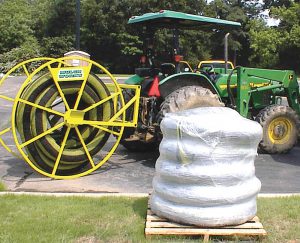
Tyler tested many different ideas and techniques as the company evolved, including use of spools to unload pallets. “Not all things worked,” he recalls.
“That one was a disaster!” Photo courtesy of Filtrexx International
Compost Containment
BioCycle: When did you introduce the Compost Filter Sock?
Tyler: I invented the Compost Filter Sock in 2001, the same year we started Filtrexx. After working with blower trucks to make berms and blankets, we struggled to get economical production so we tried to fill a sock and it worked. The socks were more efficient to install than berms. We could install several thousand feet per day instead of only a few hundred, and engineers loved the fact it was contained (compared to loose berms) and did not move.
We selected silt fence as our main target for replacing and our leading competition. It was easy to outperform a miserably designed product — engineers all agreed silt fence did not work, and they were happy to examine new options. Initial patents were applied for in 2001 and several others since, as our innovation continues. Overall, seven patents have been issued surrounding our technology, while several are pending. The earlier patents focus on the traditional replacement of silt fence for sediment control. The latest ones showcase vertical growing systems for green walls, vegetable gardens, and other progressive, high end applications.
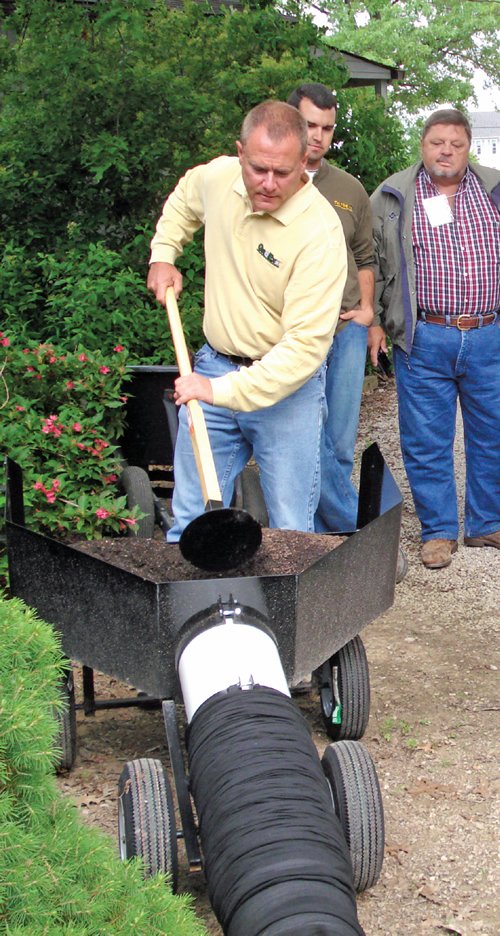
Rod Tyler demonstrates a device to fill a GardenSoxx® by hand. Photo courtesy of Filtrexx International
BioCycle: What type of compost was being used in the media?
Tyler: We only use yard trimmings compost for all Filtrexx products. The original Compost Filter Sock used medium grade composted media that I referenced earlier, with particle sizes about a half- to 2-inches. There was confusion in the marketplace about ‘what compost was’, so we changed the terms to FilterMedia™ (half to 2-inches) and GrowingMedia™ (half-inch minus) to reflect the two distinctive options for fill of the sock. GrowingMedia™ is basically a fine compost having plant growth properties for installations with vegetative growth. FilterMedia™ is a coarser product with higher flow through rate for sediment-laden water and is designed to filter water and trap sediment. Changing the terms of the fill media helped specifiers and designers better understand what is needed in preliminary designs and to follow and enforce specifications.
BioCycle: Do all the composting facilities making Filtrexx media produce both types? And what about compost quality control?
Tyler: Generally the facilities have the ability to make both. We try to source compost from operations with US Composting Council Seal of Testing Assurance (STA) certification. If they don’t have STA-certified product, we ask them to get in the program. And at a minimum, if they aren’t certified or applying for it, we send the facility’s compost to a STA-approved lab to get it tested for product assurance. And generally, compost used in our GrowingMedia™ is just plain old “vanilla” compost, no additives. Filtrexx buys compost for up to $10/cy.
Growth Spurt
From 2001 through 2008, the Filtrexx network grew to over 100 certified installers in the U.S. and Canada. During this time, Filtrexx also invested heavily in research, product performance testing, specification development, outreach and education of targeted markets — storm water managers, general contractors, DOTs, landscape architects, cities and municipalities, and ecological designers — as well as continuing to apply for patents on its various designs. New products were introduced for applications such as stream bank stabilization, pollutant removal, bioswales, green roofs, living walls and many others.
During this time period, one significant challenge remained — filling Filtrexx Soxx only with blower trucks.
BioCycle: Why was that the most significant challenge?
Tyler: Blower trucks were a barrier to entry due to their cost. It was a significant investment, especially if a business was just getting started in this marketplace. Filling socks with a blower truck was also a messy process. That’s when we invented and introduced the Filtrexx FX Machine, in 2005. It has a 2-cy capacity hopper on a universal skid steer mount. The hopper utilizes a hydraulically powered auger to move a variety of media into our patented mesh system. The price of the FX machine was $16,000. It provided a new, affordable way for Filtrexx products to go into new market areas.
Around the same time, we were getting requests from general contractors in some regions for Filtrexx Soxx that they could install themselves. We asked if they had a blower truck. When they said no, we realized that they could also benefit by having the FX Machine. But those requests pointed to a new market opportunity, and looking back, that is what changed the course of Filtrexx as a company.
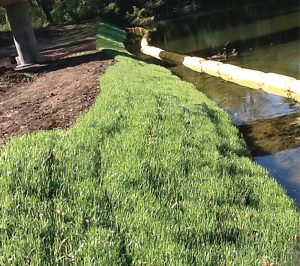
Streambank stabilization systems utilize seeded Soxx and prevent erosion of riparian areas, waterways, and shoreline banks. Photo courtesy of Filtrexx International
BioCycle: How so?
Tyler: We recognized that general contractors who used our products at their job sites might prefer the convenience of just buying sock that was “install-ready,” and that what we really needed to do was to supply them with filled sock delivered on pallets. Next, we needed to figure out how to make that happen. We discovered that the Soxx fabric we were using was too slippery to stay stacked on a pallet. The company we were purchasing Soxx from did not, at that time, have the ability to make the product we needed. At the same time, I was approached by Tompkins Brothers, a knitting machine manufacturer, to buy a machine so we could make our own socks. Long story short, we decided to vertically integrate and bought Tompkins in 2009 and renamed it Tompkins USA. We engineered a sock product that did not slide, and was more durable.
The pallets contain continuous Soxx in sizes from 8-,12-,18- and 24-inch diameter. Sections of 10 feet are common for 8- and 12-inch products. The filled Soxx are installed using a skid steer, and the process is actually much faster than silt fence. As Soxx are installed, stakes are added to anchor them at the installation site. Each pallet uses 2.6 or more cy of FilterMedia.
BioCycle: Did this ability to manufacture pallets of Filtrexx Soxx products provide the company with an opportunity to scale? Asked more simply, was this Filtrexx’s golden ticket?
Tyler: Without a doubt. This new palletizable Soxx that did not slide allowed rapid advancement of palletization, which led to scale, which led to what I call our Big Mac®. Everything started clicking like clockwork when we started making prefilled, palletized, shrink wrapped sock. It was that moment, in 2005 that I saw pallets as being the vehicle to get us to true growth mode, while scaling to provide for anyone that wanted the product. Ironically, however, we never really starting making pallets seriously for another 5 years.
BioCycle: What was the impact of this new product on the Filtrexx certified installers since you were going directly to the contractors?
Tyler: The downturn in the economy in 2008 hit many of our installers hard and they went out of business. This made us vulnerable in terms of market coverage. We didn’t have a blower truck, but we could ship pallets. In 2011, we terminated all exclusive installer contracts, and wanted those companies to produce pallets and have the service. Ones that decided to do it got our Big Mac® spreadsheet —our ‘standardization’ for each size, including length, diameter, number of stakes, label, type of shrink wrap, weight, etc. We took this model national, and very quickly we had about 40 pallet/Soxx manufacturing locations across U.S. Standardization allowed rapid expansion with the lowest possible capital cost.
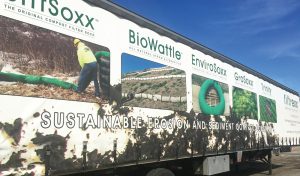
Signage on semi trailer that transports palletized Soxx promotes some of Filtrexx’s signature products and illustrates growth of the product line and its applications. Photo courtesy of Filtrexx International
Selling The Company
BioCycle: In 2014, you decided to sell Filtrexx International to a company called Conwed. What led you to that decision? What was attractive to Conwed?
Tyler: The thing I lacked was a strategic partner so I could grow Filtrexx faster. Conwed manufactures the yarn that we were buying to make the mesh. When you look at the value chain, in 2008 Filtrexx bought the company that made the netting and in 2014, the company that makes the yarn ends up buying both our knitting division from Tompkins and all of Filtrexx. And in the summer of 2014, Conwed also bought Weaver Express, an install company in Ohio. That now gives Filtrexx, under this new ownership, the ability to do installs. Several years ago, there was a huge market for Soxx in Ohio and Pennsylvania due to the fracking boom.
It’s important to look at value adds with a company like Filtrexx. Assume that $1 worth of mesh is worth $3 to $4 on a pallet, and that same pallet is worth $10 installed. This multiplier effect provides incentive for vertical integration in any industry. If you have the capital, you want to also buy the company that gets the $10 for the install. If you do an install such as a living wall to stabilize a streambank, instead of simply a silt fence replacement, the value of that filled sock increases even more — closer to $20.
This value-added principle applies equally to the value of compost itself, which we recognized early on in Filtrexx’s development. Say an installer is blowing compost at $40/cy. That same cubic yardage of product, when put in an 8-inch Filter Soxx, is worth $2/linear foot. There are 60 linear feet in one cubic yard, so the value of that same product is $120/cy instead of $40/cy.
BioCycle: How does the Filtrexx success story translate to compost manufacturing entrepreneurs in 2017 in terms of how to grow their companies? What are your words of wisdom?
Tyler: You need to pick markets that others aren’t tapping right now. High quality compost has so many ecosystem benefits, and the key is to find the “delivery mechanism” to tap those markets. Don’t sell compost. Sell what that compost does, i.e., growing media, filter media.
I believe there are three very important elements to success. The first is differentiation. Filtrexx products aren’t like anything else. The second is exclusivity — early on in our development, we provided exclusive territories due to the local customer investment in local marketing — it was significant for them and us. And the third is performance. Your product has to outperform the product(s) that is being used now. Silt fence is a good example of that. During this comparison, life cycle costs of the product were analyzed by U.S. EPA. The agency found that compost filter socks were a much better cost in the long run compared to silt fence (link at biocycle.net in online version of this article).
I think we solved a lot of the problems on the erosion side. For any company to make money, it needs recurring sales in a market that grows with a profit margin that is sustainable — for the products Filtrexx focuses on, we’ve made this work well. My challenge to the industry is to find a new application for compost that no one else has thought of yet that will use 10 million cy/year. Or, better yet, challenge local specifiers to make the change by outlawing silt fence — which is a $2 billion dollar market sector. If that is all they do, they will have created a market for nearly a billion yards of compost. That’s only one tool in the toolbox!
The Sustainable Site, our design manual published in 2010, showcases 25 designs. Soxx for silt fence replacement is only one of these applications!! The rest is waiting for industry to just change habits — the composting and the storm water industries.


